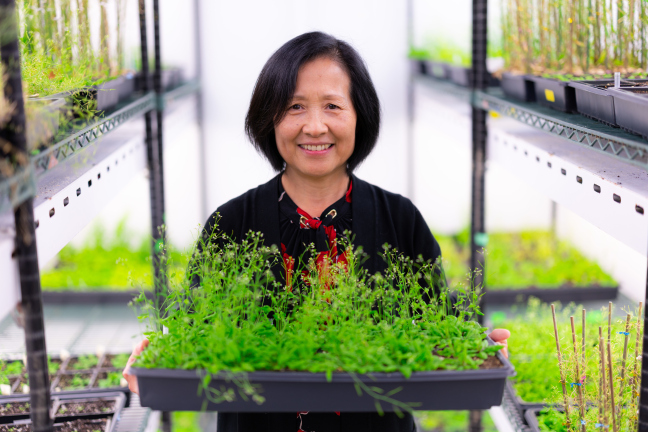
Hongqing Guo, assistant professor of genetics, development and cell biology, inside a plant growth room in the basement of the Advanced Teaching and Research Building. She is holding a tray of Arabidopsis thaliana, the plant she uses to study a gene that controls both growth and survival response. Photo by Christopher Gannon/Iowa State University. Larger image.
AMES, Iowa – Hongqing Guo studies a gene that affects both how plants grow and how they respond to environmental threats, hoping to unravel – and then harness – the balancing act between fortifying and flourishing.
“Unfavorable conditions tell a plant to slow down growth so they can survive. But when that happens to crops, we lose yield. We’re trying to figure out how plants manage to survive adverse conditions and still grow, so we can make them more resilient as environments change,” said Guo, an assistant professor of genetics, development and cell biology at Iowa State University.
Understanding the trade-off between growth and survival responses could help plant scientists put their thumb on the scale, designing crops that still produce well under stress. But the gene Guo focuses on, Feronia, is central to many aspects of plant life, which makes it challenging to determine how it carries out any individual role. To cut through the clutter, Guo’s research team is zooming in for a closer look.
Single-cell study
Feronia is found in most plants’ cell membranes and is named for an ancient goddess of fertility, as reproduction is one of the first functions it was linked to when discovered about two decades ago. Biologists have since shown it regulates thousands of genes affecting a wide range of processes, a list that continues to expand. Guo and several colleagues published a study in 2022 that examined Feronia’s effects and mechanisms by analyzing transcriptome and proteome data, a global assessment that connected Feronia to even more signaling pathways.
The gene’s prolific impact complicates traditional loss-of-function research, as using gene editing to completely knock out Feronia affects a plant in multiple and seemingly unrelated ways – stunting growth and fertility and increasing sensitivity to pathogens, salt and extreme temperatures, for instance.
“Feronia does so much that it can mask the important things we’re trying to study,” she said.
Guo’s research team – in collaboration with Iowa State graduate and California Institute of Technology assistant professor Trevor Nolan – hopes narrowing its attention will bring more clarity. The researchers are using single-cell RNA sequencing to study Feronia within individual cells and cell types of Arabidopsis thaliana, a flowering plant commonly used in plant and genetic research. They’re also using CRISPR gene-editing tools to turn off Feronia’s functions selectively instead of across the entire plant, by limiting the knockout to certain cell types.
Using cell-type specific gene manipulation, Guo found that knocking out Feronia in different layers of a root leads to different outcomes.
“We found that Feronia function in the outer layer of roots is especially interesting compared to its function in other cell types. So we are looking at epidermis cells to see what Feronia is interacting with to achieve its effects,” she said.
Flexible first-time grant
Guo’s work led to a new five-year, $1.8 million grant from the National Institute of General Medical Sciences, a branch of the National Institutes of Health. The grant, called Maximizing Investigators’ Research Award for Early Stage Investigators (MIRA), is for highly promising researchers early in their careers.
Though she’s been a researcher at Iowa State since 2004 and began studying Feronia in 2009, Guo is a relatively new faculty member. She didn’t pursue her doctorate when her children were young, but she always planned to return to it eventually. She began the doctoral program at Iowa State in genetics and genomics in 2013 and earned her Ph.D. in 2019, collaborating along the way with famed Duke University plant biologist Philip Benfey before his death last fall. After a couple years as an adjunct professor, she was hired in a tenure-track role in 2022. She credits her father for instilling in her a sense of perseverance.
“He always told me that the sky is the limit,” she said.
The MIRA grant will help Guo keep going in whatever direction she’d like in studying Feronia. Most research grants fund a proposed project. A MIRA grant instead funds the researcher.
“That gives me a lot of flexibility. You have the freedom to work on the most exciting fronts and spend more time mentoring students and post-docs,” she said.
Guo is using a portion of the funds to develop a new undergraduate course tentatively called Fighting Climate Change with Plants, a lab-based class designed to give first-year students a formative experience with research. Hands-on science is an opportunity many new students crave, Guo said. Connecting with motivated students also helps her research.
“They bring fresh eyes and fresh ideas. And sometimes they ask excellent questions I’ve never thought about before,” she said.
Contacts
Hongqing Guo, Genetics, Development and Cell Biology, hguo@iastate.edu, 515-451-2648
Dave Roepke, News Service, dcroepke@iastate.edu, 515-294-4845
Quick look
An Iowa State University plant biologist received a $1.8 million federal grant to study a gene that affects both how plants grow and how they respond to environmental threats. Unraveling the balancing act between fortifying and flourishing could help scientists develop crops that are more resilient in challenging conditions.
Quote
“We’re trying to figure out how plants manage adverse conditions and still grow, so we can make them more resilient as environments change.”
Hongqing Guo, assistant professor of genetics, development and cell biology
More news
Find more Iowa State University news and research stories at news.iastate.edu.